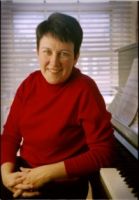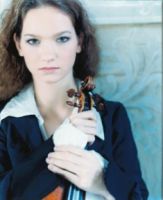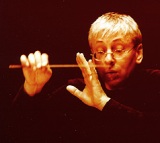
Higdon, Hahn and Schubert in Indianapolis
There was a mystery about Jennifer Higdon’s Violin Concerto,
which received its world premiere Feb. 7 at Hilbert Circle Theater in
Indianapolis.

But not about its success,
which was manifest by repeated curtain calls for violinist Hilary Hahn, the
Indianapolis Symphony Orchestra and ISO music director Mario Venzago.
The mystery involved the meaning of “1726,” title of the concerto’s first movement (Benjamin Franklin and Philadelphia, home of Higdon and Hahn’s alma mater the Curtis Institute of Music?). The first six people to solve it were offered an autographed copy of the score, a new twist in marketing that continues to brand Higdon, not only as one of America’s finest composers, but one of its savviest.
Commissioned for Hahn by the ISO, the Toronto and Baltimore Symphonies and Curtis, Higdon’s Violin Concerto is a brilliant work, 35 minutes of color, gesture and pizzazz couched in diatonic harmonies and infectious rhythms.
It’s full of
challenges, too – even for Hahn, at 29 one of the world’s finest fiddlers. A memory slip part way into the fiendishly
difficult finale, forced her to stop and begin again, endearing her even
further to the ISO audience, which demanded two encores (Preludio from Bach’s
E-flat Major Partita and Schubert’s “Erlkönig,”
arranged for violin by Heinrich Wilhelm Ernst).

“1726” begins delicately, with soft harmonics by the solo violin, joined in the sixth bar by glockenspiel and crotales struck with knitting needles. It unfolds as an expansion and variation on the rhythmic/motivic pattern set at the outset, culminating in a “ferocious” cadenza (so labeled by the composer). Crotales placed on the timpani drumhead and struck while moving the pedal up and down added a wavy, piquant sound near the beginning and end.
The second movement, Chaconni (plural for chaconne, or variations on a repeated harmonic pattern) opens with woodwind choir and contains lush, romantic writing for solo winds and strings in addition to the violin. This collegial aspect gave it an occasional chamber music-like feel, but there are rich, full textures, too, where the orchestra soared. Hahn emerged from one of these tutti sections and ascended to a stratospheric high E over tranquil strings at the end.
The finale, “Fly
Forward,” means just that, a relentless, moto perpetuo movement with scarcely a
dozen bars of rest for the violin, most in preparation for the explosive run-up
at the end.
Higdon’s Concerto, while the main
course, wasn’t the only treat on the program.
Venzago led the ISO in a dramatic Overture to Weber’s “Die Freischütz” and a Symphony
No. 4 by Robert Schumann that had one scrambling for adjectives.
ISO music director since 2007, Swiss-born
Venzago, 60, has strong ideas, including how to perform Schumann’s
symphonies. As he remarked in a
pre-concert lecture, Venzago views them as “piano music for orchestra,”
implying “freedom to take time and improvise.”
Düsseldorf, closely
associated with Schumann, took notice in October, 2008 when the Düsseldorf
Symphony named Venzago “Robert Schumann Guest Conductor.” He will lead a Schumann cycle there during
the composer’s bicentennial in 2010. (Trained
as a pianist, Venzago has recorded the complete Schumann symphonies with the
Basel Symphony, of which he is conductor laureate.)

Barely into the
restless introduction, his Schumann Fourth was intensely hyper-romantic. There were frequent rubatos, and he dwelt on
its melodic riches to delicious effect.
He literally danced on the podium during the Scherzo, taken at a
moderate tempo, and he created a shiver effect during the slow introduction to
the finale so that the fortissimo Lebhaft
had a real feeling of arrival. The beaming,
personable conductor, clearly a favorite in Indianapolis, bowed long and low to
the orchestra before turning to acknowledge the applause at the end.
(first published in American Record Guide, May-June, 2009)